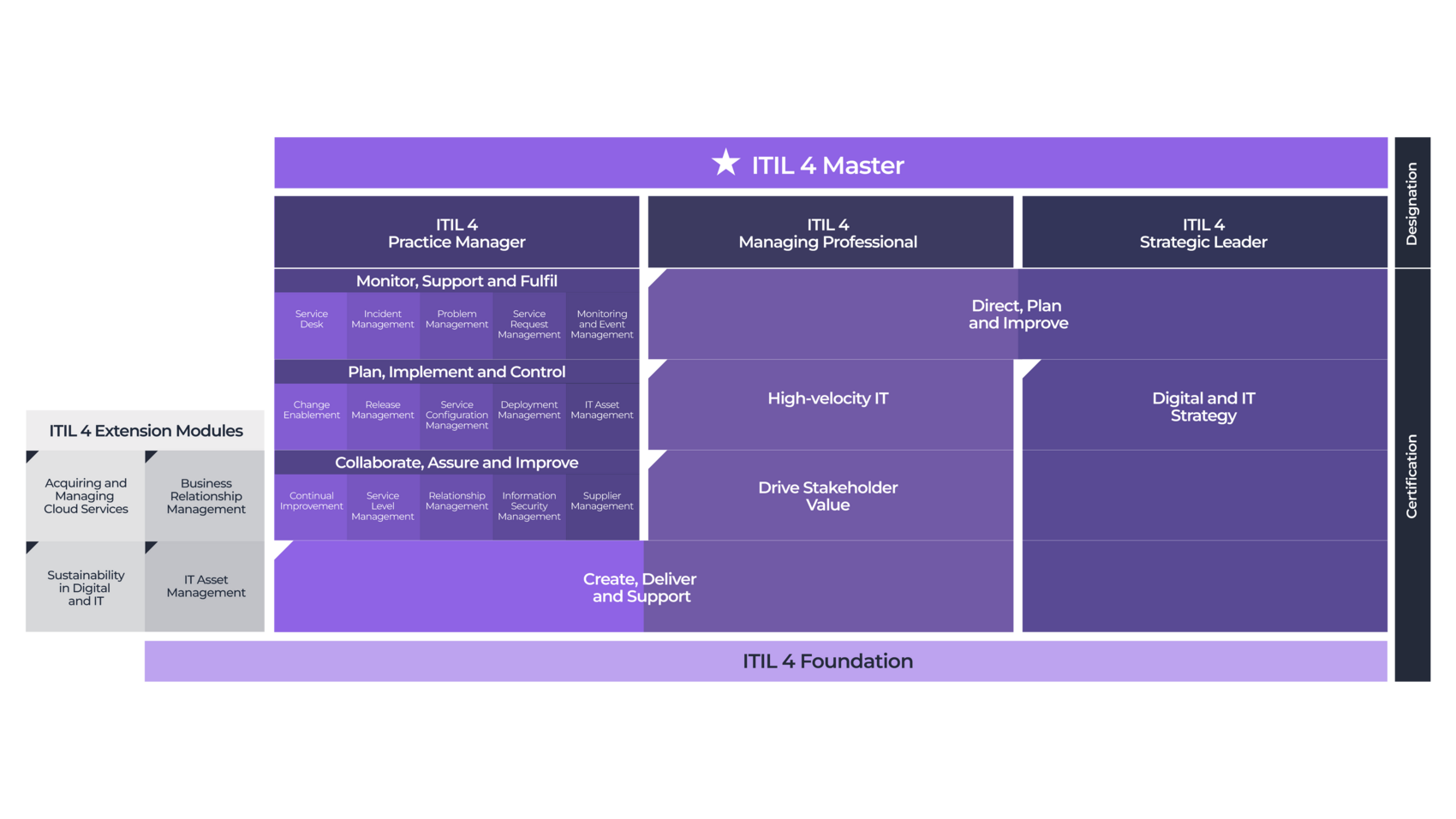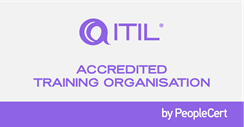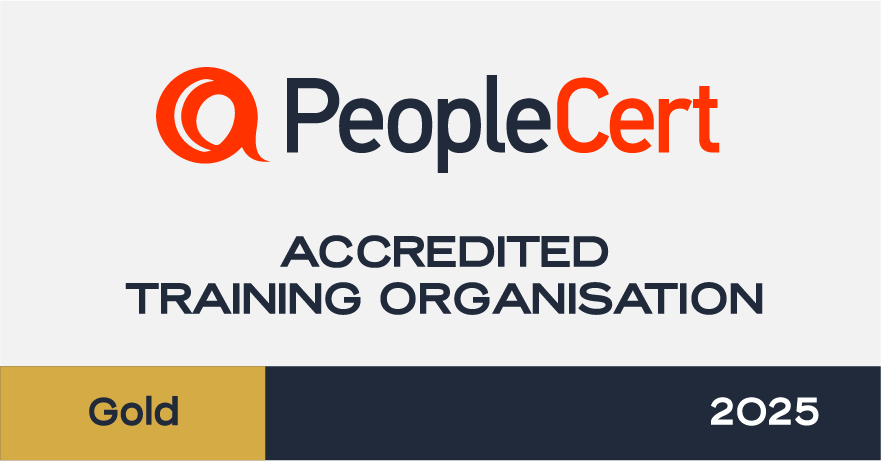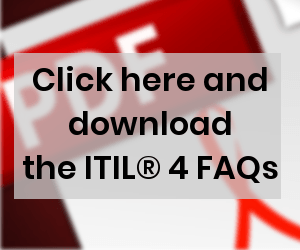ITIL® 4 Courses
ITIL 4 certification training courses and exams based on ITIL methodology and framework
ITIL® 4 is the world's leading IT service management framework, offering a flexible approach that adapts to any organization, regardless of size or industry. Enhance your career prospects and earning potential with an ITIL 4 certification, the standard for IT service management excellence.
ITIL 4 Certification Levels:
- ITIL® 4 Foundation: Establishes a foundational understanding of the ITIL 4 framework and its key concepts.
- ITIL® 4 Managing Professional (MP): Equips you with the skills to manage IT services, teams, and workflows effectively.
- ITIL® 4 Strategic Leader (SL): Focuses on the alignment of IT and business strategies.
- ITIL® 4 Practice Manager: Provides in-depth knowledge and expertise in specific ITIL practices.
- ITIL® 4 Extension Modules: Specialized certifications to deepen your knowledge in specific areas such as sustainability in digital and IT.
Why Choose ITIL® 4?
- Globally Recognized: ITIL 4 is the go-to framework for IT service management professionals worldwide.
- Adaptable: The framework can be tailored to suit any organization, ensuring a structured and efficient approach to service management.
- Career Advancement: An ITIL 4 certification demonstrates your expertise and commitment to service management excellence, opening doors to new opportunities.
- Increased Earning Potential: Certified ITIL 4 professionals typically command higher salaries and enjoy greater job security.
Availability and prices of ITIL® 4 courses
ITIL 4 online courses (e-learning) with exams
In this showcase you will find a selection of training courses, exams and mock exams concerning ITIL® 4 Edition.
If you do not see a specific ITIL course or ITIL exam, please contact us.
ITIL 4 online exams
In this showcase you will be able to purchase ITIL exam vouchers only (ITIL v4) to take the online exams on PeopleCert portal, in complete autonomy, 24 hours a day.
ITIL 4 distance - live virtual courses calendar
In this showcase you will find the next available dates for ITIL 4 online courses (live virtual sessions) with certification exam. These courses are provided via web-conference in real time by our ITIL accretited trainers. ITIL 4 certification exams will be taken online on PeopleCert portal.
Summary of Topics
What is ITIL® 4?
What is ITIL® (Information Technology Infrastructure Library) is a widely recognized and globally adopted framework, renowned for its best practices in IT Service Management. Over time, ITIL has evolved from its initial version in the late '80s, known as ITIL v1, to subsequent versions like ITIL v2, which emerged in the early 2000s. The update in 2007, often referred to as ITIL v3, was more accurately labeled as ITIL 2007. Subsequently, in 2011, the latest edition, ITIL 2011, was published. Recently, ITIL® 4, the latest version of the framework, was introduced in 2019.
For individuals seeking ITIL certification, ITIL online courses are available through platforms like iLEARN, offering self-paced, classroom, or remote learning options. ITIL 4 Edition has been meticulously designed to address the challenges posed by the intricate digital landscape of today. This new qualification scheme is backward compatible with ITIL v3 and aims to facilitate a smooth transition from ITIL Foundation level onwards.
Notably, ITIL Practitioner level, Intermediate level (ITIL® v3 Service Lifecycle, and ITIL® v3 Service Capability), and ITIL® v3 Managing Across Lifecycle level will be replaced by new, more streamlined modules in ITIL 4, ensuring an up-to-date and simplified learning experience. Embracing ITIL version 4 equips organizations with the necessary tools to navigate the complexities of the modern digital world effectively and efficiently.
What is ITIL® 4 useful for?
Enrolling in ITIL training courses (ITIL4 course) is instrumental in achieving effective IT Service Management implementation based on best practices. Such learning initiatives bring a plethora of benefits to organizations, and these advantages become even more pronounced as the organization's size and dependency on digital technology grow.
Key experienced benefits of learning ITIL and implementing ITIL 4 include:
- Marked improvement in IT services efficiency, effectiveness, and availability.
- Significant reduction in costs through streamlined processes and resource optimization.
- Heightened customer satisfaction resulting from a more refined and customer-centric approach to service delivery.
- Increased productivity as employees embrace standardized ITIL practices and methodologies.
- Enhanced utilization of skills and experience within the organization to drive better service outcomes.
- Improved service delivery compared to relying solely on third-party providers.
By empowering their workforce with ITIL knowledge and leveraging ITIL 4 principles, organizations can unlock the full potential of their IT Service Management, paving the way for enhanced operational performance and sustainable growth.
How do I get ITIL® certified?
The ITIL Qualification Scheme (ITIL 4 Edition) offers a modular approach to acquiring competences in the ITIL framework and encompasses a range of qualifications covering various aspects of ITIL Best Practice, each varying in depth and detail. Within this scheme, individuals can pursue different ITIL qualifications, with each module having an associated ITIL exam that allows them to demonstrate their acquired competences and obtain certification.
What is an ITIL certification? The ITIL certification and qualification Scheme (ITIL 4 Edition) consists of the following modules.
Each module is culminating in an ITIL 4 exam to validate competences and grant certification, enabling candidates to achieve an ITIL certification online. 
There are four levels of ITIL certifications and qualifications:
ITIL Foundation (ITIL 4 Foundation edition)
The ITIL Foundation examination, often referred to as ITIL 4 Foundation edition, serves as the entry-level certification, providing end-learners with a comprehensive understanding and knowledge of the fundamental elements, concepts, and terminology used in ITIL. The ITIL Foundation course and certification are specifically designed for entry-level IT professionals seeking a basic comprehension of ITIL or those aspiring to advance within the ITIL 4 certification scheme. This certification's primary objective is to acquaint candidates with contemporary IT-enabled service management. Achieving the ITIL Foundation certification entails passing the ITIL Foundation exam, which follows the completion of the corresponding ITIL course at the Foundation level.
ITIL 4 Extension Modules
The ITIL® 4 Extension Modules are intended to enable organizations to maximize value from through the adoption of the globally recognized ITIL 4 framework as part of the ITIL 4 certification scheme. These certifications extend the main ITIL 4 framework and provide organizations with the guidance to address and harness the challenges and opportunities presented by emerging technologies and themes that impact their operations.
There are four modules that comprise of the ITIL 4 Extension Modules: ITIL® 4 Specialist: Sustainability in Digital & IT, ITIL® 4 Specialist: Acquiring & Managing Cloud Services, ITIL® 4 Specialist: Business Relationship Management and ITIL® 4 Specialist: IT Asset Management.
The ITIL 4 Extension Modules certifications can be achieved by passing the corresponding exam after the completion of the related ITIL course.
ITIL Managing Professional (ITIL MP)
ITIL Managing Professional (ITIL MP) targets IT practitioners working within technology and digital teams across businesses. The Managing Professional (MP) stream provides practical and technical knowledge about how to run successful IT projects, teams and workflows.
ITIL Managing Professional path integrates three specialist modules (ITIL 4 Specialist: Create, Deliver & Support, ITIL 4 Specialist: Drive Stakeholder Value and ITIL 4 Specialist: High Velocity IT) and the module ITIL Strategist Direct, Plan & Improve. All modules are valuable independently but all 4 exams must be completed to obtain the ITIL Managing Professional designation.
The ITIL Managing Professional modules mandates completion of ITIL 4 Foundation as a prerequisite.
The ITIL 4 Managing Professional certifications can be achieved by passing the corresponding exam after the completion of the related ITIL course.
After achieving the ITIL Managing Professional designation, if candidates are interested in pursuing the ITIL Strategic Leader stream, they would only need to complete the ITIL course "ITIL Leader: Digital & IT Strategy" and to pass the corresponding exam.
ITIL Strategic Leader (ITIL SL)
ITIL Strategic Leader stream recognizes the value of ITIL, not just for IT Operations, but for all digitally enabled services. Becoming an ITIL Strategic Leader (ITIL SL) demonstrates that the professional has a clear understanding of how IT influences and directs business strategy.
ITIL Strategic Leader integrates the ITIL Strategist Direct, Plan & Improve and ITIL Leader Digital & IT Strategy module. Both modules are valuable independently, but both must be completed to obtain the ITIL Strategic Leader designation.
The ITIL 4 Strategic Leader certifications can be achieved by passing the corresponding exam after the completion of the related ITIL course.
ITIL Practice Manager (ITIL PM)
The modules included in this stream are based on the 34 ITIL 4 management practices. These modules provide shorter and more flexible training, and the modules can be mixed and matched according to each student’s needs.
This stream is composed by three batches, including 5 individual practices each (see the picture above):
- ITIL 4 Monitor, Support & Fulfil
- ITIL 4 Plan, Implement & Control
- ITIL 4 Collaborate, Assure & Improve
The ITIL Practice Manager designation can be achieved by completing 5 individual practices plus the ITIL Specialist: Create, Deliver and Support module, or by completing an ITIL 4 PM combined exam (covering the 5 modules of each batch) plus the ITIL Specialist: Create, Deliver and Support module
ITIL Master
All candidates must start with ITIL Foundation for both ITIL Managing Professional and ITIL Strategic Leader certifications schemes to gain a basic understanding of the core concepts and principles of ITIL 4.
Candidates can then work towards becoming either an ITIL Managing Professional (ITIL MP), an ITIL Strategic Leader (ITIL SL) or an ITIL Practice Manager (ITIL PM) by completing the relevant courses and exam.
If candidates complete all the streams, gaining the three designations, they will be eligible for assessment to become an ITIL Master.
Learning Digital Assistant for ITIL 4 courses
iLEARN has introduced its brand-new service, the Learning Digital Assistant, a study support service that aids you in learning the content for all ITIL 4 certifications, thanks to the integration of Artificial Intelligence into our eLearning platform. Add it to your course by selecting it as an option during the purchase of your ITIL package, or purchase it by selecting the product in the showcase at the beginning of this page.
Discover all the details about your new virtual personal guide for ITIL 4 training.
Earn PDUS with ITIL® 4
Our ITIL (ITIL 4 edition) training courses can provide Professional Development Units (PDUs) through an auto-declaration procedure on PMI’s portal. Here below you can find more details about the PDUs allocation for each level of the ITIL certification scheme:
- ITIL® Foundation: 16 PDUs
- ITIL® 4 Specialist: Create, Deliver and Support (ITIL CDS): 21 PDUs
- ITIL® 4 Specialist: Drive Stakeholder Value (ITIL DSV): 21 PDUs
- ITIL® 4 Specialist: High Velocity IT (ITIL HVIT): 21 PDUs
- ITIL® 4 Strategist: Direct, Plan and Improve (ITIL DPI): 21 PDUs
- ITIL® 4 Leader: Digital & IT Strategy (ITIL DITS): 21 PDUs
To learn more about the PDUs allocation according to the PMI Talent Triangle and to discover all of our online training courses and exam packages for each certification level, click on one of the links above.
Please note that, in order to auto-declare PDUs attending this course provided by iLEARN, the purchase of the attendance confirmation (attendance certificate) in electronic format (pdf) is mandatory. Select the option to add the attendance confirmation at the moment of purchase and proceed to checkout.
For more information about PDUs and how to claim them to maintain your PMI qualifications, please visit this page.
How can I study ITIL® 4?
The ITIL 4 courses are run by accredited ITIL trainers and they are designed based on solid experiences in the implementation of ITIL in IT organisations of all sizes and sectors.
iLEARN ITIL v4 courses can be attended in different ways:
- Classic ITIL 4 training
- on pre-scheduled dates (upon calendar): traditional classroom training at iLEARN premises
- in-house: traditional classroom training scheduled based on client needs and at customer's or iLEARN premises
- Distance/remote ITIL learning: attending a live remote classroom by means of a web conference
- ITIL training in E-Learning / self-paced learning: training provided through our online learning management system from anywhere and anytime
- ONE-to-ONE ITIL courses: access to e-Learning platform and interactive sessions via web-conference with the accredited trainer
Attending an ITIL course in any of our delivery options you will also get:
- ITIL training material accredited by PeopleCert
- Official ITIL sample papers (provided by PeopleCert)
- Official PeopleCert ITIL digital manuals
- ITIL accredited trainers support
USEFUL LINKS
Our e-learning platform is optimized for access via web browers, including mobile!

 Login
Login

